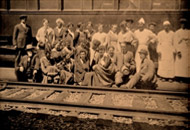City Directories and History: R&R has divided the 1938 SCDOT map of McCormick County into (20) sectional maps. Many of the individually listed schools and churches shown on this section are pictured. However, in many cases, the individual site also has its own post on R&R, which often provides added information and image. Be wise and use the search function to locate all of the entries for this and other homeplace listings.
Click on the HOME link to return to the master list.
Stay Connected
Explore history, houses, and stories across S.C. Your membership provides you with updates on regional topics, information on historic research, preservation, and monthly feature articles. But remember R&R wants to hear from you and assist in preserving your own family genealogy and memorabilia.
Visit the Southern Queries – Forum to receive assistance in answering questions, discuss genealogy, and enjoy exploring preservation topics with other members. Also listed are several history and genealogical researchers for hire.
User comments welcome — post at the bottom of this page.
HISTORY OF MCCORMICK SCHOOLS – Written and contributed to R&R by author and historian, Bobby E. Edmonds – 2014.
Nettie F. McCormick donated McCormick’s first pretentious school building in 1884. Nettie McCormick took her usual close interest in details of constructing this building. She hired a young architect, A. Page Brown, to draw the plans and supervise the construction. The academy was a simple, substantial building on a hill overlooking the town. The town rejoiced and celebrated the completion of the academy by holding a “Grand Educational Barbecue.”
At first there was only one teacher, and instead of the conventional grade system classes were arranged according to the books available. An early student reported, “Each pupil brought what books he could. Should two pupils have the same books, they were placed in a class together.” Improving with the years, the school served its purpose until in 1912 it was replaced by a larger structure.
McCormick Academy
Built in 1884 In 1895, Governor Ben Tillman’s Constitutional Convention reorganized the South Carolina public school system. It provided for free public education for children of both races on a segregated basis. To support the schools, the Constitution provided for a poll tax, to go to the respective school districts in which collected. In addition, the school districts were empowered to levy property taxes for school purposes. With these changes public school education began to improve.
By 1916, schools were located in twenty-seven school districts in McCormick County, 1. Mt. Carmel, 2. Willington, 3. Bordeaux, 4. McCormick, 5. Buffalo, 6. Bellvue, 7. Flat Woods, 8. Bethia, 9. Bold Branch, 10. Young, 11. Wideman, 12. Chestnut Ridge, 13. Millway, 14, Robinson, 15, Dornville, 16. Bethany, 17. Lyon, 18. Hibler, 19. Vernon, 20. White Town, 21. Talbert, 22. Beaver Dam, 23. Red Hill, 24. Plum Branch, 25. Parksville, 26. Modoc, 27. Clarks Hill.
Attendance was fairly equally divided by race in the various school districts, for example, records show Willington, white 120, colored 120, McCormick, white 197, colored 224, Buffalo, white 50, colored 50, Flat Woods, white 124, colored 120, Chestnut Ridge, white 81, colored 46, Robinson, white 126, colored 112.
McCormick County children attended sixty-four schools that dotted the towns and countryside in 1919: Bailey Bethel, Beaver Dam, Bellvue, Bethany, Bethia, Blue Branch, Bold Branch, Bordeaux, Cedar Springs, Chappels, Clarks Hill, Clay Hill, Dark Corner, Dornville, Ebenezer, Edmunds, Flat Rock, Glover Chapel, Green Olive, Hard Labor, Hibler, Holloway, Holy Springs, Hosanah, Johnson, Kitchens, Lethe, Liberty Hill, Little Mill, Lyon, Mars, McCormick, Missions, Modoc, Morrows, Moss, Mt. Carmel, Mt. Moriah, Mt. Pleasant, Mt. Vernon, Mt. Zion, Mulberry, New Hope, Oak Grove, Parksville, Pine Grove, Plum Branch, Poplar Hill, Red Hill, Rehoboth, Rock Ford, Rock Grove, Sandy Hill, Shady Grove, Shiloh, Springfield, St. Charlotte, St. Mary, St. Paul, Talbert, Tranquil, Wideman, Willington, Wilson Woods.
Wideman School was a typical community school – one-room, one-teacher, through grade ten. Built of logs in 1896 on a lot provided by John Wideman, Wideman School served the children of the Wideman / Red Row community.
Luther W. Bowick, who began attending Wideman School in 1901, recalled “the difficulty of “keeping the cold winter wind from seeping through mud-filled cracks between the logs, and uncomfortable homemade benches and desks. Students hovered closely in order to soak up scanty heat from the open-hearth fireplace in one end of the schoolroom. The teacher allowed older boys enough time between classes each day in winter to cut enough wood to last all day and enough to start the fires the next morning.”
Bowick said, “Sam Willis, called ‘Mr. Sam’ by the scholars, practiced strict discipline. Each day he removed his buggy whip to the classroom to assure the class he meant business.
“Scholars brought lunch in pails crammed with such foods as fried chicken, fried fatback, potatoes, buttered biscuits, and home-made molasses.
“During recess we played games such as ball, chase, hide-and-go-seek, and sliding down red gullies.
“School lasted from 9:00 in the morning until 4:00 in the afternoon with one hour for recess. School terms lasted three to four months, the length determined mainly by availability of school funds. Subjects taught included, arithmetic, geography, spelling, writing, and some science. Most of these books were carried forward to the next year. An individual student’s progress governed in which group he or she participated. A slower student was held back until minimum requirements were met.
“Scholars also performed their work responsibilities on the family farms, including hoeing and picking cotton, planting, pulling and shucking corn, and working in vegetable gardens“ Scholars from the Sharpton family used a foot-log to cross a creek on their way to and from school. Sometimes a freshet prevented them from getting to school or home due to the foot-log being under water. They hoped for rain before school rather than after.
“The schoolhouse served another purpose. Dr. S. W. Reid, pastor of Pressly Memorial Associate Reformed Presbyterian Church in McCormick, and his wife conducted Sunday school on Sunday afternoons for students and adults. During a week in July revival services were held at Wideman School.
“In 1906 a new frame structure was erected, measuring twenty-four feet long and sixteen feet wide, with two doors and three windows, and an open-hearth fireplace in one end. There were homemade desks, a blackboard (repainted twice a year), water bucket and dipper, a teacher’s desk and chair. Nails were driven into the wall in rows, lower and higher, for scholars’ coats, hats, and caps.
“Some of the teachers at Wideman School over the years were Sam Willis, Nora Cuddy, Daisy Gable, Parrie Watkins, Mary Rhine, Edna Duncan, Rosella Talbert, Georgia Talbert, Helen Bradley Browne, Carrie Coleman, Nell Dowtin, and Ella Stone.”.
Daisy E. Bowen started to Wideman School in 1932. She said, “Avis T. Britt came to teach in 1922. She was concerned about each and everyone she taught. She wanted them to be proud of the fact that they came from a country school.
“Girls took turns cleaning the yards and the building. This, with shades over the windows and new curtains hung, made the school look home-like.
“At times I had to go to school standing in my brother’s hip pockets so I wouldn’t get my shoes muddy.
“From 1922 to 1932 an average of twenty-two pupils attended Wideman School. Reading, writing, and arithmetic, along with Bible, songs, deportment and home life were taught. Pupils all knew they must be able to pass the test required in order to be promoted. This they did verbally and in writing. Many verses and chapters were learned from the Bible, along with religious and patriotic songs. On Friday of each week, the Sunday School lesson was studied and discussed, and every child was encouraged to go to Sunday school and church on Sunday and to behave.
“From the years 1928 to 1930 there was an adult school, the first in the county. Many learned to read and write. Adult students were helped with home economics to assure that the home-maker was made aware of every advantage of stretching her household dollar as well as food values.
“In 1935 a coal heater was purchased and coal was used instead of wood. A porch was added on the front for convenience during rainy days. The porch was used by older students who sometimes worked on their homework before going home.
“The Works Progress Administration (WPA) was active in the Wideman Community during FDR’s New Deal. A lunchroom was added in 1935 to the rear of the school and hot lunches served.”
Wideman School was closed in 1952.
In 1944 there were forty-four public schools in the McCormick County. Students were segregated by schools. Five school busses transported a portion of white children. No school busses were provided for black children.
In response to a South Carolina legislative school building act, school districts initiated a massive building program in the early 1950s.
A new Mims High School was constructed. The old building, enlarged and modified, became Mims Elementary School. New elementary schools were constructed at Plum Branch and Willington. The number of schools was reduced to seven: McCormick High, Mims High, McCormick Elementary, Plum Branch Elementary, Mims Elementary No. 1, Mims Elementary No. 2, and Mims Elementary No. 3.
This map may be viewed in its entirety by clicking HOME to return to the SCDOT index page.
Stay Connected
Explore history, houses, and stories across S.C. Your membership provides you with updates on regional topics, information on historic research, preservation, and monthly feature articles. But remember R&R wants to hear from you and assist in preserving your own family genealogy and memorabilia.
Visit the Southern Queries – Forum to receive assistance in answering questions, discuss genealogy, and enjoy exploring preservation topics with other members. Also listed are several history and genealogical researchers for hire.
User comments welcome — post at the bottom of this page.
Please enjoy this structure and all those listed in Roots and Recall. But remember each is private property. So view them from a distance or from a public area such as the sidewalk or public road.
Do you have information to share and preserve? Family, school, church, or other older photos and stories are welcome. Send them digitally through the “Share Your Story” link, so they too might be posted on Roots and Recall.
Thanks!

